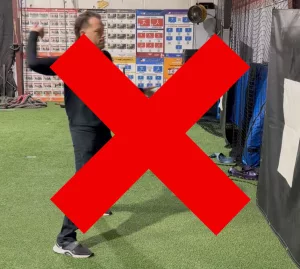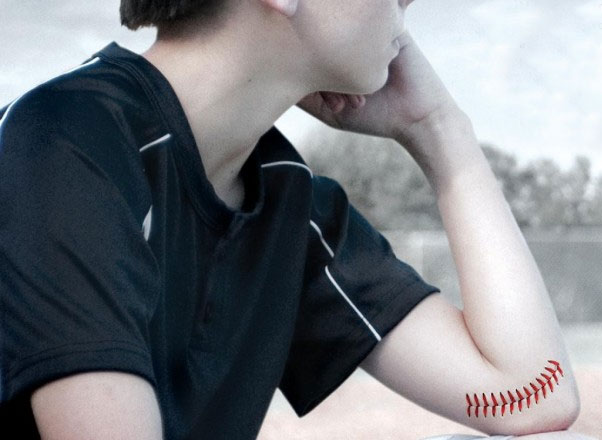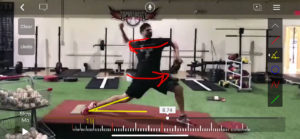![]() Baseball pitchers frequently have elbow pain pitching, which can have a variety of causes. When pitching, the elbow joint can experience tremendous strain that can result in inflammation, discomfort, and even damage. Elbow pain pitching can also be a result of poor technique or overuse. Little league elbow is a type of elbow ailment that affects baseball pitchers frequently and is brought on by the repetitive stress of pitching a ball. This ailment, which is characterized by discomfort and inflammation in the elbow's growth plate, is frequently brought on by weakness, overuse, and or improper throwing technique. Strains, sprains, and tendinitis are some elbow problems that pitchers in baseball might experience. Baseball pitchers must take precautions to avoid elbow pain, including maintaining good technique, abstaining from overuse, and strength training to enhance joint strength. Additionally, it's crucial to get on daily routines that adhere to a suitable strength development plan in order to guarantee that injury is avoided or adequately treated.
Baseball pitchers frequently have elbow pain pitching, which can have a variety of causes. When pitching, the elbow joint can experience tremendous strain that can result in inflammation, discomfort, and even damage. Elbow pain pitching can also be a result of poor technique or overuse. Little league elbow is a type of elbow ailment that affects baseball pitchers frequently and is brought on by the repetitive stress of pitching a ball. This ailment, which is characterized by discomfort and inflammation in the elbow's growth plate, is frequently brought on by weakness, overuse, and or improper throwing technique. Strains, sprains, and tendinitis are some elbow problems that pitchers in baseball might experience. Baseball pitchers must take precautions to avoid elbow pain, including maintaining good technique, abstaining from overuse, and strength training to enhance joint strength. Additionally, it's crucial to get on daily routines that adhere to a suitable strength development plan in order to guarantee that injury is avoided or adequately treated.
Understanding the causes of elbow pain in baseball pitchers
 It’s crucial to comprehend the reasons why baseball pitchers have elbow pain in order to successfully avoid and treat the condition. Overuse is among the leading causes of elbow pain in baseball pitchers. When a pitcher throws too far or too hard, the elbow joint is overstressed and this happens. Inflammation, discomfort, and even harm may result from this. Furthermore, using the wrong form or technique when throwing can also cause elbow pain. For instance, a pitcher with bad mechanics—such as one who does not use the proper sequence of the kinetic chain can put more strain on and experience pain. This ailment is commonly found in young baseball players for the exact reason mentioned in the previous sentence. Because of inexperience young athletes don't understand how to properly sequence the kinetic chain and reduce excessive stress being placed on the elbow joint. Little league elbow, a disorder that affects baseball pitchers, is another source of elbow pain. This is characterized by pain and inflammation in the elbow’s growth plate and is brought on by the repetitive stress of pitching a baseball. Overuse or poor throwing mechanics are frequent causes. Baseball pitchers can also get various sorts of elbow ailments, such as strains, sprains, and tendinitis. These wounds may develop as a result of a single traumatic event or over time from repeated stress. When it comes to experiencing elbow pain when pitching, strength is a crucial aspect. Baseball pitchers need a lot of lower to upper body strength to generate the power and velocity necessary to throw a baseball successfully. A pitcher may experience pain and injury if they don’t have the necessary strength in the shoulders and arms because of increased stress on the elbow joint. Poor throwing mechanics, in particular, can be a result of a lack of shoulder and trunk strength, which can ultimately result in elbow pain. For instance, a pitcher may use their elbow to generate velocity if their legs and core are not strong enough, which puts too much strain on the joint. The inability of the pitcher to correctly decelerate the arm after throwing, which results in the elbow absorbing greater force, can also be a factor in elbow pain. This is because the glute and back muscles help decelerate the body. However, if those glute and back muscles are weak, they cannot function properly, causing the upper body to overwork. Baseball pitchers should concentrate on strengthening their complete kinetic chain, including their legs, hips, trunk, shoulders, and arms, to avoid elbow injury. This will ease the strain on the elbow joint and help to enhance throwing mechanics. Additionally, it’s crucial to have a healthy balance of upper body strength because imbalances can result from overworking one muscle group while underusing another. The prevention of elbow pain and damage while pitching can be aided by including a thorough strength training program, concentrating on the indicated regions, and working on proper technique. This programming is all available in the 3X Pitching Velocity Program.
It’s crucial to comprehend the reasons why baseball pitchers have elbow pain in order to successfully avoid and treat the condition. Overuse is among the leading causes of elbow pain in baseball pitchers. When a pitcher throws too far or too hard, the elbow joint is overstressed and this happens. Inflammation, discomfort, and even harm may result from this. Furthermore, using the wrong form or technique when throwing can also cause elbow pain. For instance, a pitcher with bad mechanics—such as one who does not use the proper sequence of the kinetic chain can put more strain on and experience pain. This ailment is commonly found in young baseball players for the exact reason mentioned in the previous sentence. Because of inexperience young athletes don't understand how to properly sequence the kinetic chain and reduce excessive stress being placed on the elbow joint. Little league elbow, a disorder that affects baseball pitchers, is another source of elbow pain. This is characterized by pain and inflammation in the elbow’s growth plate and is brought on by the repetitive stress of pitching a baseball. Overuse or poor throwing mechanics are frequent causes. Baseball pitchers can also get various sorts of elbow ailments, such as strains, sprains, and tendinitis. These wounds may develop as a result of a single traumatic event or over time from repeated stress. When it comes to experiencing elbow pain when pitching, strength is a crucial aspect. Baseball pitchers need a lot of lower to upper body strength to generate the power and velocity necessary to throw a baseball successfully. A pitcher may experience pain and injury if they don’t have the necessary strength in the shoulders and arms because of increased stress on the elbow joint. Poor throwing mechanics, in particular, can be a result of a lack of shoulder and trunk strength, which can ultimately result in elbow pain. For instance, a pitcher may use their elbow to generate velocity if their legs and core are not strong enough, which puts too much strain on the joint. The inability of the pitcher to correctly decelerate the arm after throwing, which results in the elbow absorbing greater force, can also be a factor in elbow pain. This is because the glute and back muscles help decelerate the body. However, if those glute and back muscles are weak, they cannot function properly, causing the upper body to overwork. Baseball pitchers should concentrate on strengthening their complete kinetic chain, including their legs, hips, trunk, shoulders, and arms, to avoid elbow injury. This will ease the strain on the elbow joint and help to enhance throwing mechanics. Additionally, it’s crucial to have a healthy balance of upper body strength because imbalances can result from overworking one muscle group while underusing another. The prevention of elbow pain and damage while pitching can be aided by including a thorough strength training program, concentrating on the indicated regions, and working on proper technique. This programming is all available in the 3X Pitching Velocity Program.
Identifying the symptoms of common elbow injuries in baseball pitchers
 To correctly diagnose and treat an elbow injury in a baseball pitcher, it's critical to recognize the signs of common elbow problems. Baseball pitchers who sustain elbow injuries frequently experience pain and discomfort, edema, stiffness, and weakening. The most typical sign of elbow injury among baseball pitchers is pain and discomfort. The upper arm or even the inner or outside aspect of the elbow may be painful. It may be an acute or dull pain that gets worse when throwing or doing other things. It is crucial to remember that pain may not always be there but may instead appear gradually over time. Another typical sign of elbow injuries is swelling. Inflammation or fluid accumulation in the joint may be the reason for this, which can result in stiffness and a reduction in range of motion. Additionally, stiffness may be experienced throughout the day but may be worse in the morning or after periods of inactivity. Another sign that can show up in the elbow joint is weakness. A muscle strain, tendinitis, or other injury affecting the tendons or muscles that attach to the elbow may be the reason for this. This could make it difficult to lift or grip objects, or to toss a ball. To accurately diagnose the injury and create a treatment plan, here at TopVelocity we can do a physical examination. To avoid further damage and guarantee a full recovery, it is crucial to treat the injury carefully. You can also start the Fast Arm Recovery system when you signup for the TopVelocity Patreon.
To correctly diagnose and treat an elbow injury in a baseball pitcher, it's critical to recognize the signs of common elbow problems. Baseball pitchers who sustain elbow injuries frequently experience pain and discomfort, edema, stiffness, and weakening. The most typical sign of elbow injury among baseball pitchers is pain and discomfort. The upper arm or even the inner or outside aspect of the elbow may be painful. It may be an acute or dull pain that gets worse when throwing or doing other things. It is crucial to remember that pain may not always be there but may instead appear gradually over time. Another typical sign of elbow injuries is swelling. Inflammation or fluid accumulation in the joint may be the reason for this, which can result in stiffness and a reduction in range of motion. Additionally, stiffness may be experienced throughout the day but may be worse in the morning or after periods of inactivity. Another sign that can show up in the elbow joint is weakness. A muscle strain, tendinitis, or other injury affecting the tendons or muscles that attach to the elbow may be the reason for this. This could make it difficult to lift or grip objects, or to toss a ball. To accurately diagnose the injury and create a treatment plan, here at TopVelocity we can do a physical examination. To avoid further damage and guarantee a full recovery, it is crucial to treat the injury carefully. You can also start the Fast Arm Recovery system when you signup for the TopVelocity Patreon.
Things to do if you experience elbow pain when pitching
If you are experiencing pain in the elbow joint whether it is from a single traumatic event or repetitive throwing with incorrect throwing motion. There are nonsurgical treatments that can be implemented to prevent the need for surgery. When elbow injuries are caught before significant stress is placed on the ulnar collateral ligament or (UCL) it is possible to implement precautionary measures and prevent a complete tear. By stabilizing the elbow, throwing athletes can gain some pain relief. Prioritizing rest, applying ice, and after any inflammation has reduced, you can begin strengthening the surrounding muscles to significantly reduce the risk factors of creating a lasting injury. No injury should be taken lightly. However, athletes should be extra cautious when coming back from an elbow injury, and gradually incorporate throwing back into their routine. With the Top Velocity 3X pitching program, we utilize medball drills to reduce stress on the arm and prevent overuse injury. These medball drills are ideal for gradually developing the endurance that is required to stop injuries in their tracks and rehabilitate the dormant muscles. The next section of this article will go into more detail on how to prevent overuse injuries.
The importance of proper technique and mechanics in preventing elbow pain
 It is impossible to overestimate the value of excellent mechanics and technique in preventing elbow pain in baseball pitchers. The elbow joint can become inflamed, irritated, or even injured as a result of improper technique and mechanics. Paying close attention to appropriate throwing mechanics and technique is one of the best methods to avoid elbow injury. Baseball pitchers can improve their mechanics and technique with the aid of the 3X Pitching Velocity Program, which also helps them gain the strength they need to stay healthy. To enhance throwing mechanics and lessen strain on the elbow joint, the program has a strong emphasis on improving the full kinetic chain, which includes the legs, hips, trunk, shoulders, and arms. In order to prevent injuries, the program stresses the value of adequate warm-up and cool-down exercises, as well as rest and rehabilitation. A thorough strength training component is also a part of the 3X Pitching Velocity Program, which is intended to improve upper body strength, especially the shoulders and arms, as well as lower the chance of injury. To increase power and velocity, the program makes use of workouts designed specifically for the demands of throwing a baseball, such as med ball throws, plyometric exercises, and strength training. In conclusion, baseball pitchers must use good technique and mechanics to avoid elbow injury. Baseball pitchers who use the 3X Pitching Velocity Program can improve their mechanics and technique while also gaining the strength they need to stay healthy. Pitchers can lower their risk of elbow pain and injury and boost their performance on the field by putting an emphasis on appropriate mechanics, strength, and rehabilitation. Preventative measures are the key to solving most elbow injuries, which is why the Top Velocity 3x Pitching Velocity Program places so much emphasis on developing the proper throwing mechanics.
It is impossible to overestimate the value of excellent mechanics and technique in preventing elbow pain in baseball pitchers. The elbow joint can become inflamed, irritated, or even injured as a result of improper technique and mechanics. Paying close attention to appropriate throwing mechanics and technique is one of the best methods to avoid elbow injury. Baseball pitchers can improve their mechanics and technique with the aid of the 3X Pitching Velocity Program, which also helps them gain the strength they need to stay healthy. To enhance throwing mechanics and lessen strain on the elbow joint, the program has a strong emphasis on improving the full kinetic chain, which includes the legs, hips, trunk, shoulders, and arms. In order to prevent injuries, the program stresses the value of adequate warm-up and cool-down exercises, as well as rest and rehabilitation. A thorough strength training component is also a part of the 3X Pitching Velocity Program, which is intended to improve upper body strength, especially the shoulders and arms, as well as lower the chance of injury. To increase power and velocity, the program makes use of workouts designed specifically for the demands of throwing a baseball, such as med ball throws, plyometric exercises, and strength training. In conclusion, baseball pitchers must use good technique and mechanics to avoid elbow injury. Baseball pitchers who use the 3X Pitching Velocity Program can improve their mechanics and technique while also gaining the strength they need to stay healthy. Pitchers can lower their risk of elbow pain and injury and boost their performance on the field by putting an emphasis on appropriate mechanics, strength, and rehabilitation. Preventative measures are the key to solving most elbow injuries, which is why the Top Velocity 3x Pitching Velocity Program places so much emphasis on developing the proper throwing mechanics. 



